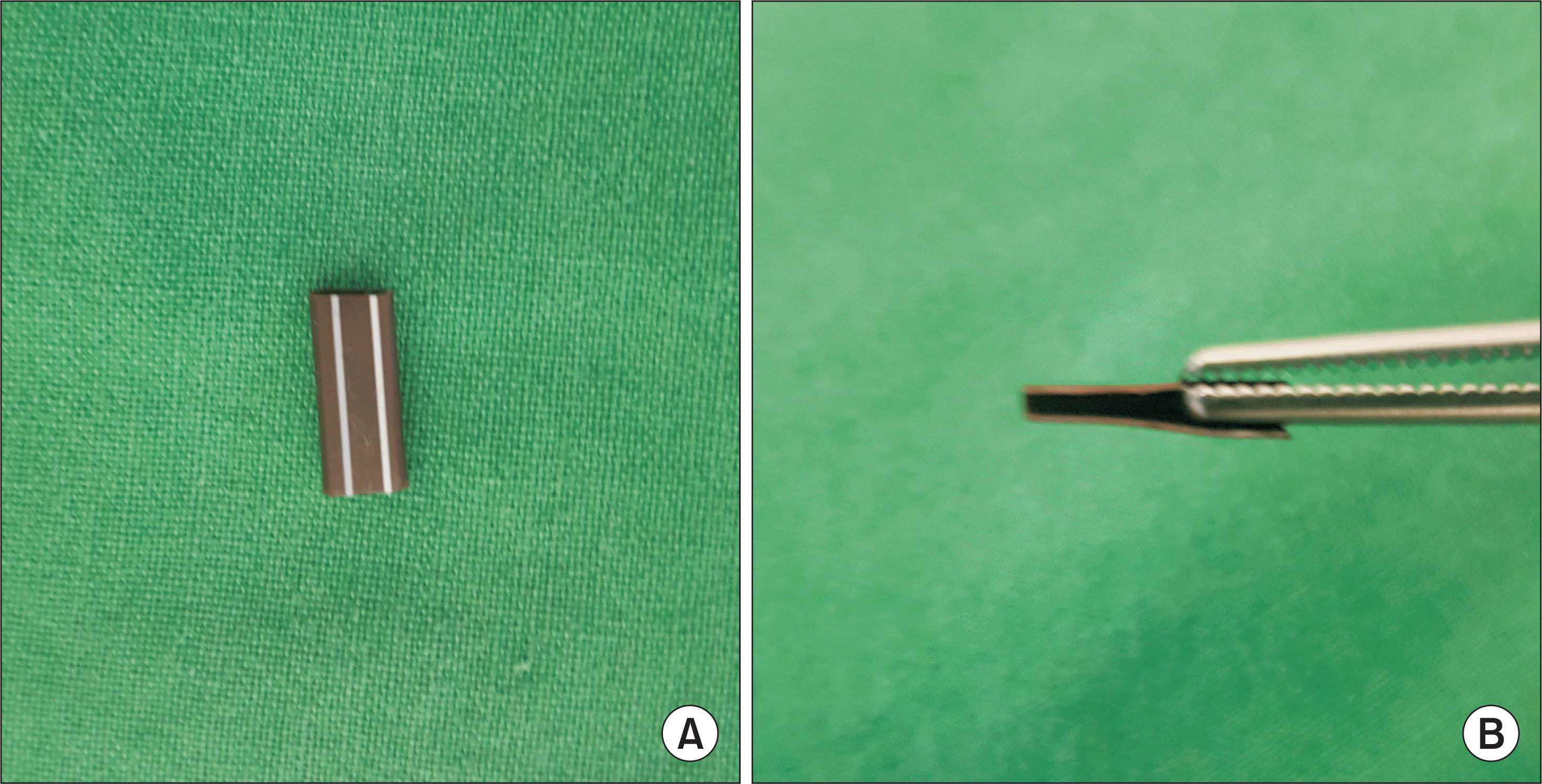Abstract
Purpose
Ingrown toenails are a common disease in the adolescent period and the treatments could be more conservative for this early stage of the disease. This study is a case series on the results of a gutter splint for an adolescent ingrown toe nail as a simple, comfortable treatment method.
Materials and Methods
From 2011 to 2018, 22 patients (mean age, 12.2 years; range, 8∼15 years) with ingrown toenails were treated with a gutter splint. There were 16 boys and 6 girls with 7 patients on both great toes, and additional 4 both corners of a nail, giving a total of 33 splints. Flat, plastic straws and glue or suture were used to protect the nail corners under local anesthesia. The medical records were reviewed retrospectively and phone calls were made to obtain the long-term results.
Results
Fifteen splints were fixed with a suture and the other 18 splints were fixed with glue. There were 9 cases of recurrence out of 33 gutter splints, 8 out of 15 sutured splints and 1 out of 18 glued splints (p=0.010). There was no gender (p=0.383) or age (p=0.305) difference in the number of recurrences.
Go to : 
References
1. Aksakal AB, Oztas P, Atahan C, Gurer MA. Decompression for the management of onychocryptosis. J Dermatolog Treat. 2004; 15:108–11.

2. Freiberg A, Dougherty S. A review of management of ingrown toenails and onychogryphosis. Can Fam Physician. 1988; 34:2675–81.
3. Zaraa I, Dorbani I, Hawilo A, Mokni M, Ben Osman A. Segmental phenolization for the treatment of ingrown toenails: technique report, follow up of 146 patients, and review of the literature. Dermatol Online J. 2013; 19:18560.

4. Yang G, Yanchar NL, Lo AY, Jones SA. Treatment of ingrown toenails in the pediatric population. J Pediatr Surg. 2008; 43:931–5.

5. Mitchell S, Jackson CR, Wilson-Storey D. Surgical treatment of ingrown toenails in children: what is best practice? Ann R Coll Surg Engl. 2011; 93:99–102.

6. Lloyd-Davies RW, Brill GC. The aetiology and outpatient management of ingrowing toenails. Br J Surg. 1963; 50:592–7.

7. Zuber TJ, Pfenninger JL. Management of ingrown toenails. Am Fam Physician. 1995; 52:181–90.
8. Heifetz CJ. Ingrown toenail: a clinical study. Am J Surg. 1937; 38:298–315.
9. Rauch C, Cherkaoui-Rbati M. Physics of nail conditions: why do ingrown nails always happen in the big toes? Phys Biol. 2014; 11:066004.

10. Grover C, Khurana A, Bhattacharya SN, Sharma A. Controlled trial comparing the efficacy of 88% phenol versus 10% sodium hydroxide for chemical matricectomy in the management of ingrown toenail. Indian J Dermatol Venereol Leprol. 2015; 81:472–7.

11. Eekhof JA, Van Wijk B, Knuistingh Neven A, van der Wouden JC. Interventions for ingrowing toenails. Cochrane Database Syst Rev. 2012; 4:CD001541.

12. Ceren E, Gokdemir G, Arikan Y, Purisa S. Comparison of phenol matricectomy and nail-splinting with a flexible tube for the treatment of ingrown toenails. Dermatol Surg. 2013; 39:1264–9.

13. Haricharan RN, Masquijo J, Bettolli M. Nail-fold excision for the treatment of ingrown toenail in children. J Pediatr. 2013; 162:398–402.

14. Shih YH, Huang CY, Lee CC, Lee WR. Nail brace application: a noninvasive treatment for ingrown nails in pediatric patients. Dermatol Surg. Published online May 2. 2018; doi:10. .1097/DSS.0000000000001530.
Go to : 
 | Figure 1.(A) A flat plastic straw got from ordinary cafe. (B) The straw was cut into 1 cm and split half that resembled the shape of “gutter”. |
 | Figure 2.(A) Ingrown nail treated with gutter splint fixed by suture. (B) After healing there was a small puncture that may play as a stress riser and be easily broken. (C) Ingrown nail treated with gutter splint fixed by glue. (D) Healed without any flaw. |
Table 1.
Baseline Characteristics
| Variable | Method | p-value | |
|---|---|---|---|
| Suture (n=15) | Glue (n=18) | ||
| Age (yr) | 12.8±1.4 | 11.8±2.3 | 0.168† |
| Sex | |||
| Male | 10 (66.7) | 17 (94.4) | 0.070‡ |
| Female | 5 (33.3) | 1 (5.6) | |
| Recurrence | |||
| None | 7 (46.7) | 17 (94.4) | 0.004∗,‡ |
| Recurrence | 8 (53.3) | 1 (5.6) | |
| Re-recurrence | |||
| None | 7 (46.7) | 17 (94.4) | 0.003∗,‡ |
| Once | 3 (20.0) | 1 (5.6) | |
| Twice | 5 (33.3) | 0 (0) | |
Table 2.
Univariable and Multivariable Model for Recurrence Using Binary Logistic Regression Model
| Variable | Univariable analysis | Multivariable analy | ||
|---|---|---|---|---|
| OR (95% CI) | p-value | OR (95% CI) | sis p-value | |
| Age | 0.004 (0.880∼2.343) | 0.088 | 0.011 (0.005∼0.563) | 0.305 |
| Sex | ||||
| Male | 1 (reference) | 1 (reference) | ||
| Female | 0.350 (0.213∼9.581) | 0.017 | 0.018 (0.004∼0.508) | 0.383 |
| Splint method | ||||
| Suture | 1 (reference) | 1 (reference) | ||
| Glue | 0.051 (0.005∼0.492) | 0.010∗ | 0.051 (0.005∼0.492) | 0.010∗ |




 PDF
PDF ePub
ePub Citation
Citation Print
Print


 XML Download
XML Download